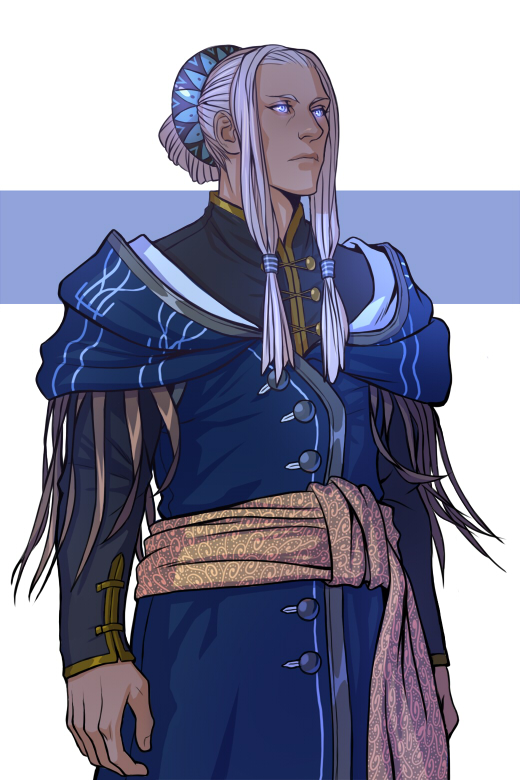Last year, I began my project on Tolkien and the representation of female characters, called “Women and Chauvinism in Middle-earth”. The analysis started with The Lord of the Rings and will continue with The Silmarillion this year. However, the focus will shift towards a more general examination of gender in Middle-earth. During my previous research, I began to realise, especially in the case of The Silmarillion, that a sole look at chauvinism or misogynism of individual characters will not suffice. Not only is it important to question the representation of female characters and femininity, but also the representation and interplay of male characters and masculinity. With its density, it is not always easy to disentangle the complexity of The Silmarillion. However brief the analysis might be, it can still shed a light on characters or aspects of the book one hasn’t considered before.
The Silmarillion is described to be an “account” of the history and creation of Middle-earth “according to the lore of the Eldar” (The Silmarillion; “Valaquenta”). It begins with a description of Eru, the Ainur and Valar, and the creation of Middle-earth. It is also the beginning of interesting concepts of gender. Those of the Ainur that “descended to [Middle-earth]” are named “Valar, the Powers of the World” (The Silmarillion; Ainulindalë). They have the ability to choose their physical shape; some of these shapes resemble elves or humans and others not:
“Now the Valar took themselves shape and hue; and because they were drawn into the World by love of the Children of Ilúvatar, for whom they hoped, they took shape after that manner which they had beheld in the vision of Ilúvatar, save only in majesty and splendour […] But when they desire to clothe themselves the Valar take upon them forms some as of male and some of as female; for that difference of temper they had even from their beginning, and it is but bodied forth in the choice of each, not made by the choice […]” (Ainulindalë).
Temper seems to stand for all those attributes and behaviours one traditionally associates with a certain gendered behaviour where some tempers possess stereotypical female attributes and other tempers possess stereotypical male traits. While the Valar have the freedom to choose their physical shape, the manifestation of the physical sex and their “temper” are not separable. In other words, femininity is widely attached to female characters while masculinity is attached to male characters as reflected in their physical manifestation. A Valar with a female temper could, theoretically, choose a male body, but decides not to. Instead, Valar with male tempers choose a male body, and female tempered Valar, also referred to as Valier, choose female bodies.
In The Silmarillion, the male Valar possess physical strength which is reflected in the professions of some. For example, Aulë being a smith, Oromë the “hunter of monster and fell beasts” or Tulkas having “delight in wrestling and contests of strength”. The emphasis in the case of the Valier, on the other hand, is on their beauty and their closeness to nature such as Yavanna, “the Giver of Fruits” or Varda’s beauty which is too great “to be declared in the words of Men and Elves” (The Silmarillion; “Valaquenta”). While the Valar and Valier are widely constructed according to stereotypical gender roles, the Valier are by no means described as inferior to the Valar. Oftentimes, the interplay and unison of both seem to create greater power. This becomes very evident when analysing individual couples such as Manwë and Varda. Due to the emphasis of Varda’s beauty, one might easily overlook that she is described to be of equal stregth, even though not necessary physical strength, and importance as any male Valar. It is not Manwë or maybe Aulë, who was “most like [Melkor] in thought and powers”, of whom Melkor afraid the most. Instead it is Varda:
“Out of the deeps of Eä she came to the aid of Manwë; for Melkor she knew from before the making of the Music and rejected him, and he hated her, and feared her more than all others whom Eru made” (The Silmarillion; “Valaquenta”).
In this short passage, there are a few interesting aspects revealed about Varda’s character. For one, she came to the aid of Manwë and not vice versa. Moreover, when Varda is besides Manwë, “he sees further than all other eyes”. Consequently, Varda is not just the “beauty” next to Lord of the “realm of Arda”. Instead, Varda and Manwë complement each other equally because “if Manwë is with her, Varda hears more clearly than all other ears”. Consequently, Varda is not just the “beauty” next to Lord of the “realm of Arda”. Instead, Varda and Manwë complement each other equally because “if Manwë is with her, Varda hears more clearly than all other ears”. Manwë and Varda represent the importance of the interplay of all Valar. Everyone, regardless of their gender, took part in the creation of Middle-earth equally.
While male characters appear to be more active, whether in war, creation, or conversations, female characters are not just passive by-standers as Cynthia L. McNew argues in The People’s Guide to J.R.R. Tolkien: “… less representation does not equal less importance”. Even in Fëanor’s creation of the Silmarils, female characters played a vital role. However, that example demands an analysis and article of its own! In other words, my next analysis will be about Fëanor and the female creation.




2 Comments